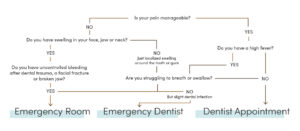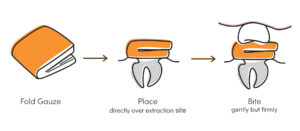How to Avoid Dry Sockets After a Tooth Extraction

Reviewed By Dr. Dennis Rollins, DDO |
July 2025 • 6 min Read
Reviewed By Dr. Dennis Rollins, DDO | July 2025 • 6 min Read
When patients tell us they’re worried about developing a dry socket, we assure them that the best preventive measures are simple and straightforward. Below you’ll find everything you need to do (and not do) to avoid a dry socket in the hours and days following a tooth extraction.
Day One (0–24 Hours After Extraction)
- Control bleeding: Your dentist will place gauze over the extraction site. Bite down firmly but gently to help a blood clot form. Only replace the gauze if and when it becomes soaked through.
- Rest and elevate: Plan to take the day off from normal activities, especially manual labor and exercise. When lying down, use pillows to keep your head slightly raised. This will help minimize bleeding and swelling.
- Protect the clot: Don’t use straws, spit forcefully, smoke, or vape. Keeping the blood clot in place is vital to preventing a dry socket, and any of these actions can pull the clot loose.
- Eat soft, cool foods: Focus on soft, nutrient-dense foods (like yogurt, soups, and smoothies) to protect the extraction site while still getting the protein, vitamins, minerals, and healthy fats your body needs. Avoid hard, crunchy, or sticky foods.
- Avoid alcohol: Alcohol can interfere with clot formation, delay healing and interact with medications—especially opioids, acetaminophen, or antibiotics.
- Follow your dentist’s instructions: If your dentist gave you pain relievers or antibiotics, take them exactly as directed. This will help you stay ahead of any discomfort, which will make the healing process smoother.
Days 2-3 (24–72 Hours After Extraction)
- Gently keep the site clean: After 24 hours, begin rinsing very lightly with warm salt water once or twice a day. Avoid forceful swishing, which can dislodge the clot.
- Brush and floss with caution: Clean your other teeth normally, but steer clear of the extraction area with your toothbrush. This way you can maintain oral hygiene while protecting healing tissue.
- Stay smoke-free: During the first 72 hours after a tooth extraction, even one cigarette or vape session can cause trouble. Keep these days smoke-free to minimize your chances of a dry socket.
- Keep taking it easy: Light physical activities like a walk is typically safe after day one, but continue to avoid vigorous workouts, heavy lifting, or sports.
- Stay dry: Continue to avoid alcohol, at least until day five.
Days 4–7+ After Extraction
- Gradually return to normal foods: As chewing becomes more comfortable, you can slowly reintroduce soft foods like pasta, scrambled eggs, or cooked vegetables. Try to chew away from the extraction site.
- Return to activity: Reintroduce exercise and physical activity, so long as the clot is stable and swelling and pain are under control.
- Maintain gentle hygiene: Continue light saltwater rinses and careful brushing and flossing around the rest of your mouth to help keep bacteria away without disturbing that all-important clot.
- Keep sipping: For best results, wait at least a full week before reintroducing straws.
- Stay smoke-free if you can: After three days, the extraction site is typically stable enough that smoking won’t spike your risk of dry sockets. Still, it’s best to wait at least a week, since smoking can irritate tissue, slow recovery, and increase your risk of infection.
- Follow up if needed: If your dentist scheduled a check-up, keep that appointment. They’ll check the extraction site, ensure healing is on track, and remove stitches if necessary.
Throughout these stages, stay alert but not anxious. As you recover, mild soreness and swelling at the extraction site are normal, but sharp, throbbing, or worsening pain is not. Trust your instincts and reach out to your dentist if you’re concerned.

Signs You Might Have a Dry Socket
In the days following your extraction, watch for these signs of dry socket.
- Severe or worsening pain at the extraction site, often radiating to the ear, eye, or neck on the same side.
- Missing blood clot or visible bone at the extraction site.
- Bad breath or a foul taste you can’t seem to get rid of.
- Swollen gums around the extraction site.
If you suspect you may have a dry socket, refrain from disturbing the area and contact your dentist or oral surgeon immediately.
Click here for help finding a dentist near you.
While a dry socket can be painful, it’s very treatable. Your dentist can clean the site, apply a soothing medicated dressing, and help manage discomfort. Most people feel significant relief within a day or two of treatment.
Tooth Extraction Timing for Women
Women may have a higher risk of a dry socket if a tooth extraction occurs during the high-estrogen phase of their menstrual cycle (around ovulation). If possible, consider scheduling your extraction during the low-estrogen phase—typically the early menstrual or luteal phase.
By the same token, contraceptives containing estrogen can increase the risk of a dry socket, especially during the high-estrogen phase of the pill cycle. It’s best to schedule an extraction during the low-estrogen phase to help reduce this risk.
Tips on Not Smoking or Vaping During Recovery
If going smoke-free for three days to a week sounds daunting, consider these methods to make it easier.
- Stock up on alternatives: Sugar-free gum or mints can help with smoking urges. It’s best to avoid them for the first three days after your extraction, but then you can reintroduce them, so long as they don’t cause any pain.
- Distract yourself: When you crave a smoke or a vape, go for a short walk, watch a show, play a game, read a book, or call a friend. Those cravings can be strong, but they usually fade within a few minutes.
- Use nicotine replacements (if approved): Ask your dentist if nicotine patches, lozenges, or gum are safe for you right after surgery.
- Avoid triggers: Steer clear of places, people, or routines that you strongly associate with smoking. Even changing up your coffee or meal habits can help.
- Focus on healing: Keep in mind that staying smoke-free is worthwhile during your recovery. Some people even use this period as a jumpstart to kicking the habit for good.
Four Dry Socket Myths
Myth 1: Only smoking causes dry sockets.
Not true. While smoking is a big risk factor, anything that dislodges the blood clot—like vigorous rinsing, using a straw, or even poking the site with your tongue—can contribute.
Myth 2: Dry sockets always happen after an extraction.
False. Only a small percentage of extractions lead to a dry socket, and there’s plenty you can do (and avoid doing) to reduce the risk.
Myth 3: Pain means you definitely have a dry socket.
Not always. Some discomfort is normal after extraction. A true dry socket usually causes severe, throbbing pain that may radiate to the ear or temple. That said, when in doubt, contact your dentist.
Myth 4: Once the first few days pass, you’re in the clear.
Not quite. Dry sockets most often appear 2–5 days after extraction, but it’s still important to follow aftercare instructions until your dentist confirms healing.
Need Help Caring for a Dry Socket?
Related Information

How Much Is a Dentist Visit Without Insurance? Exact Costs Explained
Below, you’ll find a breakdown of typical out-of-pocket costs for common dental procedures, along with the reasons behind these costs. Keep in mind that these costs can vary significantly based on your location, the dentist’s experience, the materials used, and the complexity of the procedure.

Should You Go to the ER for Tooth Pain? A Quick Guide
Whether you should go to the ER for tooth pain depends on the severity of your pain and what other symptoms you’re experiencing. Read on for help deciding how to find relief.

How to Stop Bleeding After Tooth Extraction: Easy Tips for Immediate Relief
After a tooth extraction, some bleeding at the site is normal and will usually slow down within 2-3 hours. Gentle oozing (think pink saliva) will often continue for the first 24 hours. Below you’ll find tips for helping to stop the bleeding, and how to tell the difference between normal recovery and signs that you should call your dentist.
